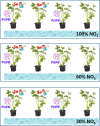Enhanced antioxidant phytochemicals and catalase activity of celery by-products by a combined strategy of selenium and PGPB under restricted N supply
- PMID: 39345979
- PMCID: PMC11427293
- DOI: 10.3389/fpls.2024.1388666
Enhanced antioxidant phytochemicals and catalase activity of celery by-products by a combined strategy of selenium and PGPB under restricted N supply
Abstract
Introduction: The reduction of N supplied combined with the use of biostimulants can be an efficient strategy that allows sustainable agriculture to achieve better economic, nutritional and environmental goals without reducing production. Moreover, the industrial processing of celery generates large amounts of waste. Therefore the purpose of this study was improve crop management strategies to reduce nitrate pollution while turning crop waste into value-added products for others sectors.
Methods: Consequently, in this work twelve treatments were examined: three N nitrogen content in the nutrient solution (100% control, 60%, and 30%) combined with the inoculation of the roots with Azotobacter salinestris, and foliar application selenium solution (8 μM, Na2SeO4). The celery parts from plants grown under limited N dose showed a higher antioxidant activity and TPC (total phenolic compounds) content.
Results and discussion: The antioxidant activity increased 28% in leaves and 41% in by-products and TPC improved 27% in leaves and 191% in by-products respect to the control. Besides, a significant reduction of β-carotene content (56%, 11% and 43% in petioles, leaves and by-products respect to the control, respectively) was obtained in plants fed with restricted dose of N. The catalase activity was not affected by N dose. The inoculation of the plants with Azotobacter, together with a reduced N dose, achieved a greater accumulation of all the parameters studied. This accumulation was maximum when Se was applied to the leaves compared with the control and depending on the celery part: TPC (121-450%); antioxidant activity (60-68%), of catalase activity (59% - 158%), and of pigments content (50-90%). These findings can boost the valorization of celery by-products as excellent source of bioactive compounds.
Keywords: antioxidant compounds; antioxidant enzyme activity; nitrogen dose; sustainable strategy; valorization of celery by-products.
Copyright © 2024 Collado-González, Piñero, Otálora, López-Marín and del Amor.
Conflict of interest statement
The authors declare that the research was conducted in the absence of any commercial or financial relationships that could be construed as a potential conflict of interest. The author(s) declared that they were an editorial board member of Frontiers, at the time of submission. This had no impact on the peer review process and the final decision.
Figures





Similar articles
-
Biofortification and Valorization of Celery byproducts Using Selenium and PGPB under Reduced Nitrogen Regimes.Foods. 2024 May 7;13(10):1437. doi: 10.3390/foods13101437. Foods. 2024. PMID: 38790737 Free PMC article.
-
Ecofriendly strategy based on the combination of inoculation with plant growth-promoting bacteria and reduced nitrate doses boosts the valorization of purple cauliflowers.Front Plant Sci. 2025 May 29;16:1571301. doi: 10.3389/fpls.2025.1571301. eCollection 2025. Front Plant Sci. 2025. PMID: 40510169 Free PMC article.
-
Improvement of Phenolic Compounds, Essential Oil Content and Antioxidant Properties of Sweet Basil (Ocimum basilicum L.) Depending on Type and Concentration of Selenium Application.Plants (Basel). 2019 Oct 29;8(11):458. doi: 10.3390/plants8110458. Plants (Basel). 2019. PMID: 31671752 Free PMC article.
-
Valorization of Fruit Waste for Bioactive Compounds and Their Applications in the Food Industry.Foods. 2023 Jan 27;12(3):556. doi: 10.3390/foods12030556. Foods. 2023. PMID: 36766085 Free PMC article. Review.
-
A Review of the Antioxidant Activity of Celery ( Apium graveolens L).J Evid Based Complementary Altern Med. 2017 Oct;22(4):1029-1034. doi: 10.1177/2156587217717415. Epub 2017 Jul 13. J Evid Based Complementary Altern Med. 2017. PMID: 28701046 Free PMC article. Review.
References
-
- Abdel Latef A. A. H., Abu Alhmad M. F., Kordrostami M., Abo–Baker A. B. A. E., Zakir A. (2020). Inoculation with Azospirillum lipoferum or Azotobacter chroococcum Reinforces Maize Growth by Improving Physiological Activities Under Saline Conditions. J. Plant Growth Regul. 39, 1293–1306. doi: 10.1007/S00344-020-10065-9 - DOI
-
- Agami R. A., Medani R. A., Abd El-Mola I. A., Taha R. S. (2016). Exogenous application with plant growth promoting rhizobacteria (PGPR) or proline induces stress tolerance in basil plants (Ocimum basilicum L.) exposed to water stress. Int. J. Environ. Agric. Res. 2, 78.
-
- Ahammed G. J., Xu W., Liu A., Chen S. (2019). Endogenous melatonin deficiency aggravates high temperature-induced oxidative stress in Solanum lycopersicum L. Environ. Exp. Bot. 161, 303–311. doi: 10.1016/j.envexpbot.2018.06.006 - DOI
LinkOut - more resources
Full Text Sources

